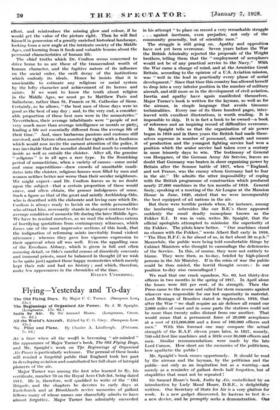No Flowers
Five Centuries of Religion. By C. C. Coulton, Vol. II. Tho AT a moment in which many view our own ecclesiastical situation with peculiar discouragement, the second instalment of Dr. Coulton's ruthless and detailed exploration of mediaeval Christianity may have at once a tonic and a soothing effect. It is consoling to be reminded at such a juncture how often institutional religion has been in a bad way, and how often it has reasserted its power : to realize that our own troubles are nothing, in comparison with those endured by our ancestors in the " ages of faith." The present volume, which surveys the religious field of Western Europe during the thirteenth and fourteenth centuries, includes of course what is often put before us as the Golden Age of Catholic culture : the period which saw the rise of the mendicant- orders, the teaching of Albertus Magnus and St. Thomas Aquinas, the flowering of Gothic art. It also deals with the swift and tragic ruin of the
mendicant ideal, as it existed in the minds of St. Francis and St. Dominic, and the general decadence of the monastic system ; a record redeemed by the lives of a few heroic saints.
This dramatic and depressing story, as revealed by con- temporary witnesses, gives Dr. Coulton a theme admirably adapted to his powers. Though the book might easily be dismissed by careless readers as mainly a dismal catalogue of monastic misdemeanours, it will be found absorbingly inte- resting by those who give it the attention it deserves. It is true that its author, when laying aside the rose-coloured spectacles of the romantic historian, seems to have replaced then► by a pair of those wanly tinted glasses which are recom- mended to persons who cannot bear strong sunlight ; glaSses which bring everything into sharp focus, but take all pleasing colour from the scene. Hence dustbins are well perceived in all their stark Unpleasantness ; but the grass does not look as green as it is really, and human beings have an unhealthy air. The reader is therefore required to make a certain imaginative
effort, and reintroduce the missing glow and colour, if he would get the value of the picture right. Then he will find himself in possession of a greatly enriched historical landscape, looking from a new angle at the intricate society of the Middle Ages, and learning from it fresh and valuable lessons about the perennial characteristics of human life.
The chief truths which Dr. Coulton seems concerned to drive home to us are those of the transcendent worth of human character, and the fugitive nature of its influence on the social order, the swift decay of the institutions which embody its ideals. Hence he insists that it is unscientific to estimate any religious or social system by the lofty character and achievement of its heroes and saints. If we want to know the truth about religion in the Middle Ages, we must go to Matthew Paris and Salimbene, rather than St. Francis or St. Catherine of Siena. Certainly, as he allows, "the best men of those days were as good as the best of any day ; and, to the very end, a consider- able proportion of these best men were in the monasteries." Nevertheless, their average inhabitants were " people of not very much more than average intelligence or morals or piety; leading a life not essentially different from the average life of their time." And, since barbarous passions and customs still survived, and Nature often asserted her rights with a frankness which would now invite the earnest attention of the police, it was inevitable that the moralist should find much to condemn inside as well as outside the cloister. After all, the genuine " religious " is in all ages a rare type. In the flourishing
period of monasticism, when a variety of causes some social and some superstitious—drew crowds of unsuitable candi- dates into the cloister, religious houses were filled by men and women neither better nor worse than their secular neighbours. We might expect—and Dr. Coulton leaves us in no doubt upon the subject—that a certain proportion of these would crave, and often obtain, the grosser indulgences of sense. Such a figure as that of the great and saintly Archbishop Odo, who is described with the elaborate and loving care which Dr. Coulton is always ready to lavish on the noble personalities who attract him, necessarily stands in sharpest contrast to the average condition of monastic life during the later Middle Ages. We have to remind ourselves, as we read the relentless catena of horrifying quotations from contemporary witnesses, which forms one of the most impressive sections of this book, that the indignation of reforming saints inevitably found violent utterance ; whereas they gave less vigorous expression to their approval when all was well. Even the appalling case of the Evesham Abbacy, which is given in full and often amusing detail, or Odo's careful census of disorderly convents and immoral priests, must be balanced in thought (if we wish to be quite just) against those happy monasteries which merely kept their rule and had no history ; and which, therefore, make few appearances in the chronicles of the time.
EVELYN UNDERHILL.







































 Previous page
Previous page